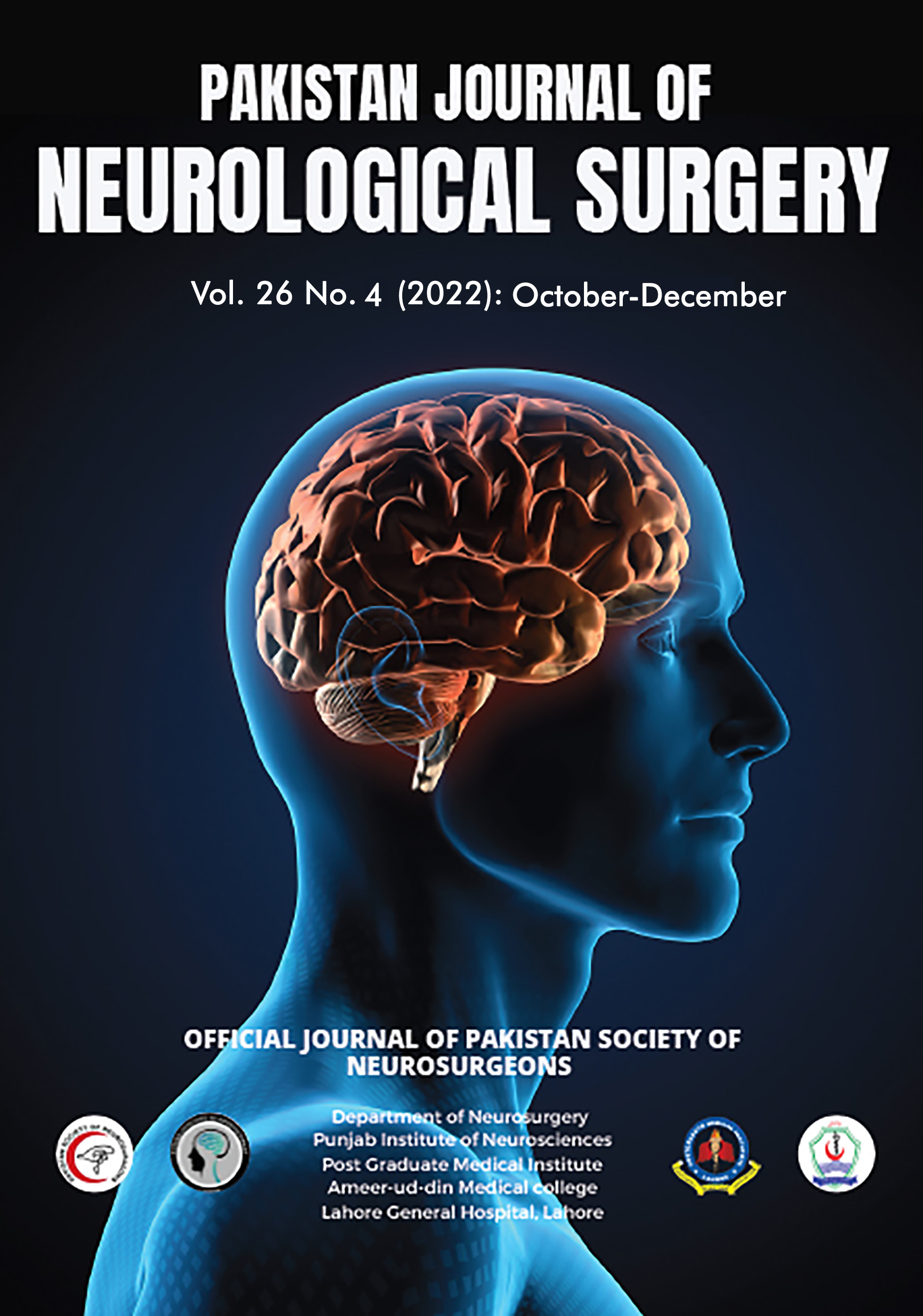Comparison of Outcomes of Early and Late Surgical Interventions in Lipomeningomyelocele (LMMC) and Lipomeningocele (LMC)
DOI:
https://doi.org/10.36552/pjns.v26i4.821Keywords:
Lipomeningocele, LipomeningomyeloceleAbstract
Objectives: The study compared the signs and symptoms of post-operative complications in early vs. late intervention lipomeningomyelocele (LMMC) and lipomeningocele (LMC).
Materials and Methods: We compared the clinical and surgical data between two groups i.e., lipomeningomyelocele (n = 189) and lipomeningocele (n = 64), and their early vs. late surgical interventions for 3 years from January 2018 to July 2021. We included patients of both genders (n = 253) with lipomeningomyelocele or lipomeningocele aged up to 7 years. A detailed neurological exam i.e., sensory, motor, and cerebellar signs was performed to evaluate the patients.
Results: The presentation of LMMC (74.7%) was very high compared to LMC (25.3%). 74.7% underwent detethering of the spinal cord, as they had cord tissue coming out of the defect. 25.2% had only meninges coming out of the bony deficiency and performed dural repairs. 47 patients had incontinence which was improved postoperatively. Sixty-nine patients had hydrocephalus which was treated with VP shunt or ETV. 23 patients had diastematomyelia which is a bony spur duly repaired intra-operatively. 50 presented with paraplegia and 19 cases with club feet. The majority of patients in both groups, reported for Power would fall between 3/5-4/5. For patients who underwent late intervention, 7 presented with post-operative incontinence, 12 with hydrocephalus, 12 with CSF leakage, and 13 with paraplegia.
Conclusion: If performed on time, surgical intervention in lipomeningocele and lipomeningomyelocele yields good results. Early intervention is substantially better for managing post-op CSF leakage and incontinence than late intervention.
References
Mühl-Benninghaus R. Spina bifida. Der Radiologe. 2018; 58 (7): 659-63.
Heuer GG, Moldenhauer JS, Scott Adzick N. Prenatal surgery for myelomeningocele: review of the literature and future directions. Child's Nervous System, 2017; 33 (7): 1149-55.
Ryznychuk MO, Kryvchanska MI, Lastivka IV, Bulyk RY. Incidence and risk factors of spina bifida in children. WiadomosciLekarskie (Warsaw, Poland: 1960). 2018; 71 (2 pt 2): 339-44.
Atta CA, Fiest KM, Frolkis AD, Jette N, Pringsheim T, St Germaine-Smith C, Rajapakse T, Kaplan GG, Metcalfe A. Global birth prevalence of spina bifida by folic acid fortification status: a systematic review and meta-analysis. American journal of public health, 2016; 106 (1): e24-34.
Polfuss M, Bandini LG, Sawin KJ. Obesity prevention for individuals with spina bifida. Current Obesity Reports, 2017; 6 (2): 116-26.
Dupépé EB, Patel DM, Rocque BG, Hopson B, Arynchyna AA, Ralee'Bishop E, Blount JP. Surveillance survey of family history in children with neural tube defects. Journal of Neurosurgery: Pediatrics, 2017; 19 (6): 690-5.
Groenen PM, van Rooij IA, Peer PG, Ocké MC, Zielhuis GA, Steegers-Theunissen RP. Low maternal dietary intakes of iron, magnesium, and niacin are associated with spina bifida in the offspring. The Journal of nutrition, 2004; 134 (6): 1516-22.
Blotière PO, Raguideau F, Weill A, Elefant E, Perthus I, Goulet V, Rouget F, Zureik M, Coste J, Dray-Spira R. Risks of 23 specific malformations associated with prenatal exposure to 10 antiepileptic drugs. Neurology, 2019; 93 (2): e167-80.
Silva-Pinto V, Arriaza B, Standen V. Evaluación de la frecuencia de espinabífidaoculta y suposiblerelación con elarsénicoambientalenunamuestraprehispánica de la Quebrada de Camarones, norte de Chile. Revistamédica de Chile. 2010; 138 (4): 461-9.
Tuite GF, Thompson DN, Austin PF, Bauer SB. Evaluation and management of tethered cord syndrome in occult spinal dysraphism: recommendations from the international children's continence society. Neurourology and urodynamics, 2018; 37 (3): 890-903.
Chan YY, Sandlin SK, Kurzrock EA. Urological outcomes of myelomeningocele and lipomeningocele. Current urology reports, 2017; 18 (5): 1-5.
Trudell AS, Odibo AO. Diagnosis of spina bifida on ultrasound: always termination? Best Practice & Research Clinical Obstetrics & Gynaecology, 2014; 28 (3): 367-77.
Eggink AJ, Roelofs LA, Feitz WF, Wijnen RM, Mullaart RA, Grotenhuis JA, Van Kuppevelt TH, Lammens MM, Crevels AJ, Hanssen A, Van Den Berg PP. In utero repair of an experimental neural tube defect in a chronic sheep model using biomatrices. Fetal diagnosis and therapy, 2005; 20 (5): 335-40.
Vora TK, Girishan S, Moorthy RK, Rajshekhar V.
Early-and long-term surgical outcomes in 109 children with lipomyelomeningocele. Child's Nervous System, 2021; 37 (5): 1623-32.
Iqbal S, Ijaz L, Butt J, Iqbal M, Nadeem MM. Early Neurological Outcome of Surgical Repair of Lipomyelomeningocele in Infants. Pakistan Journal Of Neurological Surgery, 2021; 25 (3): 391-7.
Bulsara KR, Zomorodi AR, Villavicencio AT, Fuchs H, George TM. Clinical outcome differences for lipomyelomeningoceles, intraspinal lipomas, and lipomas of the filum terminale. Neurosurgical review, 2001; 24 (4): 192-4.
Snow-Lisy DC, Yerkes EB, Cheng EY. Update on urological management of spina bifida from prenatal diagnosis to adulthood. The Journal of urology, 2015; 194 (2): 288-96.
Downloads
Published
Issue
Section
License
Copyright (c) 2022 Shahzeb Ahmad, Shakil Mashori, Syeda Kiran Zahra1, Rana Muhammad Usama, Abdul Hanan, Shmama Tu ZahraThe work published by PJNS is licensed under a Creative Commons Attribution-NonCommercial 4.0 International (CC BY-NC 4.0). Copyrights on any open access article published by Pakistan Journal of Neurological Surgery are retained by the author(s).













